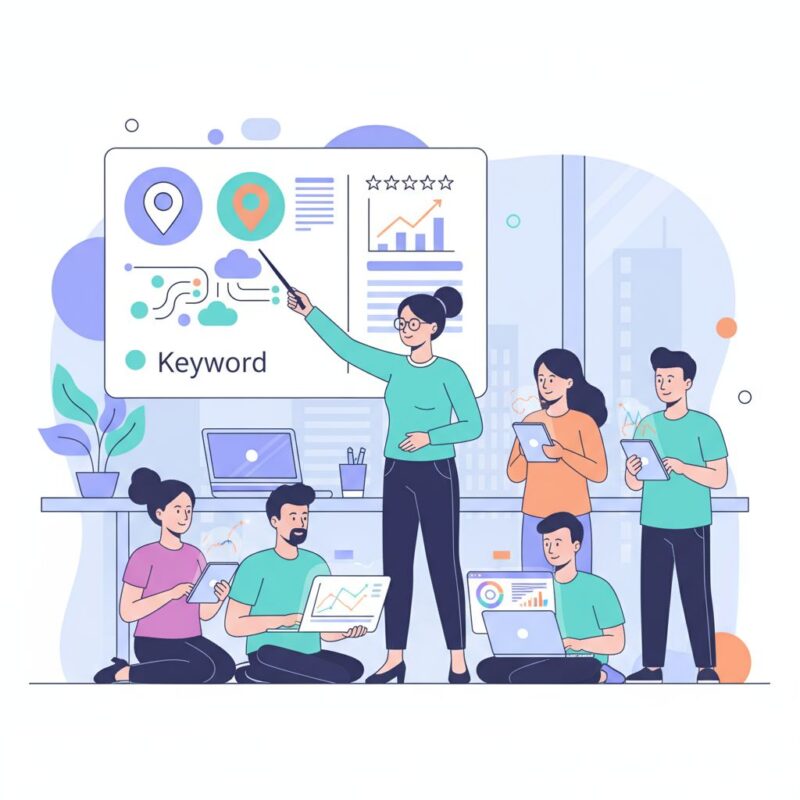- Advanced Local SEO Strategies
- Fundamentals of Local SEO
- Google Business Profile (GBP) Optimization
- Local Keywords and Content Strategy
- Local Link Building
- Local Paid Advertising
- Local Search Ranking Factors
- Local SEO Best Practices
- Local SEO Tools and Analytics
- Local Social Media Marketing
- Online Reviews and Reputation Management
- Technical SEO for Local Businesses
Local Semantic Search Optimization for Better Rankings

Google now alters over 60% of webpage titles to better match what users actually seek. This startling fact reveals a seismic shift in how modern algorithms evaluate online content. No longer just about matching exact phrases, platforms prioritize context and user intent above rigid keyword repetition.
This evolution impacts every business aiming to connect with nearby customers. Instead of chasing isolated terms, success hinges on crafting material that answers real questions in natural language. Think about how people phrase queries when looking for services near them – conversational, specific, and loaded with implied needs.
Sites adopting this approach see double the featured snippet appearances and stronger visibility. Why? Because algorithms now analyze relationships between concepts, location signals, and behavioral patterns. Your content must mirror how customers think, not just what they type.
Key Takeaways
- Modern algorithms prioritize contextual meaning over exact keyword matches
- User location and search patterns directly impact visibility for nearby services
- Natural language alignment boosts featured snippet opportunities by 2x
- Title tag optimization now requires understanding implied intent
- Content must address complete user journeys rather than isolated phrases
Understanding the Evolution of Semantic Search
Search engines once treated queries like math equations – match keywords, deliver results. Today, they decode meaning like librarians connecting ideas. This transformation began with Google’s 2013 Hummingbird update, which prioritized context over individual terms. Suddenly, “best pizza near me” wasn’t just about “pizza” but location, quality, and immediacy.
From Keywords to Context
Hummingbird introduced conceptual understanding. Instead of counting phrases, it analyzed relationships between words. When you searched “how to fix leaky faucet,” algorithms looked for repair methods – not just pages repeating “fix” and “faucet.” This shift required content to address complete problems, not isolated terms.
| Algorithm | Year | Key Feature | Impact |
|---|---|---|---|
| Hummingbird | 2013 | Contextual understanding | Reduced keyword stuffing |
| RankBrain | 2015 | Machine learning interpretation | Improved ambiguous queries |
| BERT | 2019 | Sentence context analysis | Better long-tail results |
| MUM | 2021 | Multitask unified model | Cross-language understanding |
Impact of Algorithm Updates on Search Behavior
RankBrain changed the game with two machine learning components. It compares unfamiliar queries to known patterns and ranks pages based on user satisfaction signals. BERT then amplified this by examining word order – recognizing that “coffee shop open late” differs from “late-night coffee shop.”
These updates mean your content must answer implied questions. If someone searches “plant care,” they might need watering schedules, sunlight requirements, and pest solutions – all in one guide. Algorithms now grade content completeness alongside relevance.
Exploring Local Search Trends in the Digital Landscape
Voice searches for nearby businesses have grown 3x faster than text-based queries since 2020. This shift reveals how people now interact with devices to solve immediate needs. Your audience expects answers that match their location, time constraints, and specific goals – often within seconds.
Local User Behavior and Search Intent
When asking “Where’s the closest tire shop open now?”, users want real-time availability and directions. These phrase-based requests show clear intent – immediate action. Search engines prioritize businesses providing precise details like hours, inventory, and service areas.
Mobile devices account for 78% of “near me” searches. People check maps, read reviews, and contact businesses while on the move. If your site loads slowly or lacks click-to-call buttons, you’ll miss these high-intent opportunities.
| Query Type | User Intent | Optimal Response |
|---|---|---|
| “24-hour pharmacy” | Urgent need | Current status, address |
| “Best vegan brunch spots” | Discovery | Menus, ratings, photos |
| “Plumber cost estimates” | Comparison | Pricing tiers, service areas |
| “How to fix garage door” | Informational | Step-by-step guides |
Seasonal events drive 45% of location-based searches in specific regions. Think beach gear rentals spiking before summer or HVAC services during heatwaves. Aligning content with these patterns keeps your business visible when demand peaks.
By analyzing search intent, you can create content that answers both stated and unstated needs. Someone searching “pet-friendly hotels” might also want nearby parks or vet clinics. Address these connections to build trust and relevance.
Implementing Structured Data for Enhanced Visibility
Over 40% of websites using structured data markup report improved click-through rates. This hidden code layer acts like a translator, helping platforms grasp your content’s true purpose. By labeling elements like addresses and service hours, you give crawlers precise clues about your offerings.

The Role of Schema Markup
Schema markup uses standardized tags to define your business details. Think of it as a labeling system for search engines. When you mark up your phone number as “telephone” and hours as “openingHours,” algorithms instantly recognize these data points.
Three schema types deliver the most impact for businesses:
- Local Business: Displays your physical location and service area
- FAQ Page: Powers answer boxes for common customer questions
- Organization: Builds brand authority with logos and social profiles
Benefits of Organized Data
Structured data turns vague listings into rich results. A restaurant using Recipe schema might show calorie counts and cooking times directly in search results. This clarity helps users make faster decisions while boosting your visibility.
| Schema Type | Visibility Boost | Key Data Points |
|---|---|---|
| LocalBusiness | Map pack inclusion | Address, hours, reviews |
| Product | Price comparisons | Inventory, ratings |
| Event | Calendar integrations | Dates, tickets, venues |
Google’s Structured Data Testing Tool validates your markup for errors. Voice assistants also rely on this organized information to answer queries like “Where’s the nearest hardware store?” Clean data implementation takes minutes but delivers years of search advantages.
Local semantic search optimization: Best Practices and Strategies
Creating material that resonates with nearby customers requires shifting from isolated keywords to comprehensive explanations. Focus on building resources that explore entire subjects rather than chasing single phrases. This approach helps platforms recognize your expertise while delivering value to readers.
Comprehensive topic coverage triples organic traffic compared to basic posts. Pages addressing multiple aspects of a theme rank for 4x more queries. For example, a bakery’s guide to “wedding cake design” should include flavor options, pricing factors, and local delivery logistics.
| Approach | Focus | Content Structure | Results |
|---|---|---|---|
| Traditional | Individual phrases | Short, repetitive pages | Limited rankings |
| Semantic | Topic clusters | In-depth guides | 3x more traffic |
Incorporate related terms like “custom desserts” or “allergy-friendly options” naturally. This helps algorithms connect concepts while keeping text conversational. Voice searches often use phrases like “Where can I get gluten-free cupcakes near me?” – mirror this language.
Understand regional preferences to make content locally relevant. A hardware store in Arizona might emphasize pool maintenance tools, while a Minnesota shop focuses on snow removal gear. Balance broad subject expertise with community-specific needs.
Building Topic Clusters and Enhancing Content Depth
Modern websites thrive when content connects like puzzle pieces. Topic clusters create this synergy by grouping related information around core themes. This method helps platforms recognize your expertise while guiding visitors through comprehensive resources.
Creating Pillar Pages
Start with pillar pages that cover broad subjects in detail. These act as central hubs for your main offerings. For example, a fitness center might create a “Weight Loss Fundamentals” pillar page linking to subtopics like nutrition plans or workout routines.
Supporting Subtopic Integration
Develop cluster content addressing specific aspects of your main themes. Each supporting page should:
- Explore one focused angle of the pillar topic
- Use natural links to connect related ideas
- Include clear calls to return to the main guide
| Approach | Content Focus | User Benefit |
|---|---|---|
| Pillar Page | Comprehensive overview | Central reference point |
| Cluster Page | Detailed explanations | Specific solutions |
Internal Linking Essentials
Strategic links between pages create pathways for users and crawlers. Use descriptive anchor text like “winter skincare routines” instead of generic “click here.” This clarifies relationships between your content pieces.
Prioritize links between newer pages and established pillars. A bakery’s “Wedding Cake Design” pillar could connect to new posts about seasonal flavors or dietary options. This structure strengthens your website’s topical authority over time.
Optimizing for Natural Language and Voice Search
People now ask devices questions like they’re talking to a friend. Over half of all searches will use voice commands by 2025. To stay visible, your content must mirror these casual conversations.

Leveraging Conversational Queries
Typed searches often use fragments like “plumber near me.” Voice requests sound different: “Who can fix my leaky sink today?” These longer phrases reveal urgent needs and specific details.
Create content that answers full questions. For example:
- “What’s the quickest way to unclog a drain?”
- “Where can I get emergency AC repair?”
| Typed Query | Voice Query | Optimal Response |
|---|---|---|
| “Pizza delivery” | “What pizza places deliver to downtown after 10 PM?” | List open restaurants with delivery zones |
| “Gym membership” | “How much does a gym membership cost near me?” | Pricing comparisons with local facilities |
| “Dog groomer” | “Where can I get my golden retriever groomed tomorrow?” | Availability calendars with service options |
Adapting Content for Voice Assistants
Voice answers need quick solutions. Structure content with clear headings like “3 Steps to Fix a Running Toilet.” Place direct answers in the first paragraph.
Use regional terms your audience prefers. Someone in Texas might say “HVAC repair,” while a New Yorker searches for “boiler service.” Include both phrases naturally.
Follow these steps:
- List common questions customers ask in person
- Use tools like AnswerThePublic to find voice-style queries
- Create FAQ sections with brief, action-focused answers
Harnessing AI and Machine Learning in SEO
Artificial intelligence now powers over 70% of Google’s search algorithms. These systems don’t just follow rules – they learn from user interactions to improve results. Your content must align with how machines process language and assess value.
How RankBrain Interprets Queries
RankBrain handles unfamiliar searches by comparing them to known patterns. When you type an unusual phrase, it identifies similar successful queries. This machine learning system then ranks pages based on user engagement signals like dwell time.
| Feature | RankBrain | BERT |
|---|---|---|
| Primary Focus | Query interpretation | Sentence context |
| Key Strength | Handling rare searches | Understanding prepositions |
| Data Processing | Behavior patterns | Word relationships |
| Impact | Improved ambiguous results | Better long-phrase matches |
BERT’s Contextual Breakthrough
BERT analyzes entire sentences rather than isolated words. It understands how “bank” differs in “river bank” versus “investment bank.” This natural language processing helps engines grasp your content’s true purpose.
What’s Next for AI-Driven Search
Future systems will personalize results using individual search histories and location data. Imagine getting restaurant suggestions based on your dietary preferences and past bookings. These advancements require content that addresses multiple user scenarios.
| Trend | Description | SEO Impact |
|---|---|---|
| Predictive Search | Anticipates needs before full query entry | Requires comprehensive topic coverage |
| Voice Dominance | 60% of searches will be voice-activated by 2025 | Need conversational FAQ formats |
| Visual Search | Image-based queries using smartphone cameras | Demands optimized alt text and metadata |
To stay ahead, focus on creating thorough guides that answer follow-up questions. Machines reward content demonstrating deep expertise through logical structure and clear explanations.
Improving User Engagement with Semantic Strategies
Visitors leave websites within 10 seconds 55% of the time when content doesn’t meet their needs. Matching your material to what people actually want keeps them engaged. Pages aligned with user intent see visitors staying 3x longer and exploring multiple pages.
Reducing Bounce Rates Through Contextual Relevance
Create content that answers questions before they’re asked. When someone searches “how to clean hardwood floors,” they want methods, product recommendations, and maintenance tips. Cover all angles to make visitors stay and explore.
| Approach | Bounce Rate | Time on Site | Pages Viewed |
|---|---|---|---|
| Basic Answers | 68% | 45 seconds | 1.2 |
| Context-Rich Content | 31% | 2.5 minutes | 3.8 |
Structure your site like a helpful guide. Use clear headings like “Step-by-Step Solutions” and “Common Mistakes to Avoid.” Link related articles naturally within your text. This creates paths for deeper exploration.
Test your content’s effectiveness by tracking:
- Scroll depth (how far users read)
- Return visitor rates
- Click-throughs to service pages
Users reward thorough, well-organized sites with longer visits. These positive signals tell platforms your content deserves higher visibility. Focus on solving complete problems rather than chasing single queries.
Local SEO Technical Optimization in a Semantic Era
Your website’s loading speed now directly influences where it appears in rankings. Mobile users expect pages to load in 2 seconds or less – delays cost you both visitors and credibility. Technical SEO forms the backbone of how platforms interpret and present your content to audiences.
Speed Meets Responsiveness
Slow sites frustrate users and crawlers alike. Compress images to under 100KB and leverage browser caching. Tools like Google’s PageSpeed Insights identify bottlenecks harming your performance.
Mobile-first indexing means your site must adapt flawlessly to smaller screens. Test buttons and forms on various devices. Ensure text remains readable without zooming. These adjustments help search engines recommend your pages for voice queries and map results.
Structured data relies on clean code to function properly. Validate your schema markup using Google’s tools. Errors here prevent platforms from understanding your service hours or location details.
Prioritize these technical upgrades:
- Achieve sub-3-second load times across devices
- Implement Accelerated Mobile Pages (AMP) for critical content
- Fix broken links that confuse both users and crawlers
Technical SEO isn’t about tricks – it’s building a solid foundation. When your site performs well, you earn better rankings and happier visitors. Every speed improvement and mobile adjustment strengthens your digital presence.
FAQ
How does semantic search differ from traditional keyword-based methods?
Semantic search focuses on understanding user intent and context rather than matching exact phrases. It analyzes relationships between words, entities, and topics to deliver results aligned with deeper meaning.
Why is schema markup important for visibility?
Schema markup helps search engines interpret your content by labeling elements like reviews, events, or products. This structured data improves how your pages appear in results, boosting click-through rates.
What are topic clusters, and how do they work?
Topic clusters organize content around a central pillar page linked to related subtopics. This structure signals expertise to search engines and helps users navigate comprehensive information seamlessly.
How can I optimize for voice search queries?
Voice searches are conversational, so use natural language and answer questions directly. Focus on long-tail phrases, featured snippets, and concise responses that align with spoken queries.
What role does mobile optimization play in modern SEO?
Mobile-friendly sites load faster and adapt to smaller screens, which improves user experience. Google prioritizes mobile-first indexing, so responsive design directly impacts rankings.
How do RankBrain and BERT influence search results?
RankBrain uses machine learning to interpret ambiguous queries, while BERT analyzes sentence context. Both help engines understand nuances in language, rewarding content that matches user intent.
Can internal linking improve content relevance?
Yes. Strategic internal links guide users to related information and help search engines map your site’s structure. This strengthens topic authority and distributes page equity effectively.
What strategies reduce bounce rates?
Align content with search intent and ensure readability. Use headers, bullet points, and multimedia to keep users engaged. Answer questions clearly in the first few paragraphs.














